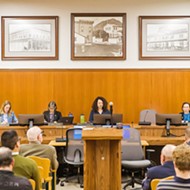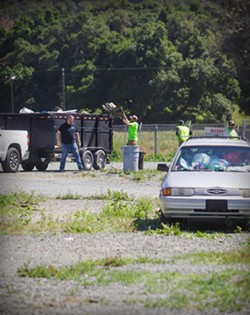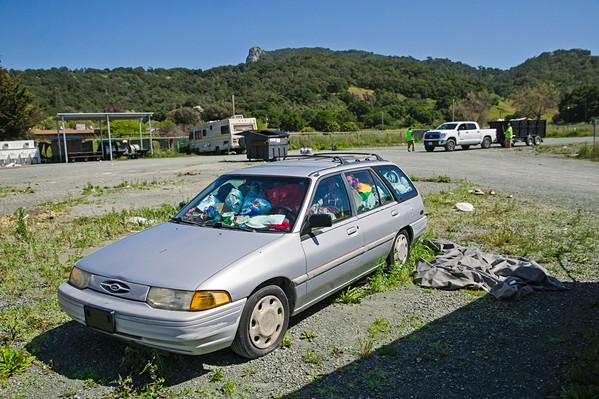Leftovers: The county cleans up what's left at Oklahoma Avenue as it faces a lawsuit over the safe parking site's closure
By Bulbul Rajagopal[
{
"name": "Newsletter Promo",
"id": "NewsletterPromo",
"class": "inlineCenter",
"insertPoint": "4",
"component": "15264767",
"requiredCountToDisplay": "0"
},
{
"name": "Ad - Medium Rectangle CC01 - 300x250 - Inline Content",
"class": "inlineCenter",
"insertPoint": "8",
"component": "15582119",
"requiredCountToDisplay": "12"
},{
"name": "Ad - Medium Rectangle LC01 - 300x250 - Inline Content",
"class": "inlineCenter",
"insertPoint": "18",
"component": "15582122",
"requiredCountToDisplay": "22"
},{
"name": "Ad - Medium Rectangle 9 - 300x250 - Inline Content",
"class": "inlineCenter",
"insertPoint": "28",
"component": "15582121",
"requiredCountToDisplay": "32"
}]
The Oklahoma Avenue safe parking site—the controversial pilot program that temporarily accommodated homeless people living in their vehicles—reverted to its original state as a vacant lot owned by San Luis Obispo County.
Legally represented by the local chapter of the California Homeless Union, the last 10 former program participants left the premises by 5 p.m. on May 6. Their exit came after a temporary restraining order filed by the union against the county sunsetted and U.S. District Court Judge André Birotte Jr. denied a preliminary injunction to keep the safe parking site open.
"He became convinced that the county was going to be able to provide some kind of housing. ... The judge also felt that the residents had not done enough themselves to find housing," homeless union lead attorney Anthony Prince said. "We disagreed with that."
The county spent $500,000 to open the Oklahoma Avenue safe parking site in 2021. It intended for its homeless participants to live on-site in their vehicles for 90 days while they sought case management from the Community Action Partnership of SLO County (CAPSLO) to transition to more stable housing.
Flaws revealed themselves almost immediately. Homeless residents found the program—located across from the SLO County Jail, and then called the Kansas Avenue safe parking site—too far away from essential services like grocery stores, gas stations, and banks. They complained about limited mental health resources, stilted care, poor communication from service providers, and lax security. The safe parking site soon became overcrowded, with peak population reaching 80 people. Eventually, a fire broke out in February 2022, killing one of the participants living in her vehicle. County officials changed the program's name to "Oklahoma Avenue" to help emergency fire and medical services locate the site quicker.
By March 2023, former county Administrative Officer Wade Horton and then Homeless Services Division Manager Joe Dzvonik admitted the safe parking site failed to meet its goal of being a temporary housing solution for the homeless. The county announced it would shutter the site and stopped admitting new participants.
The decision to close the site also meant that the remaining two dozen program participants had to eventually leave. In December 2023, Director of Social Services Devin Drake sent a letter to eight of them, alleging that they weren't cooperating with the county and its partners to find safe housing. Drake asked the eight residents to leave by mid-December. Those letters triggered a civil rights lawsuit from the homeless union against the county, CAPSLO, and related departments and leaders tasked with overseeing the safe parking site.
The county extended the exit date to February 2024. Two successful temporary restraining orders from the homeless union kept the safe parking site from closing until April 29. The orders allowed the last 10 homeless people who are plaintiffs in the lawsuit to continue staying on-site. Judge Birotte's denial of a preliminary injunction on April 24, which could have kept the site open until the lawsuit went to trial or got settled, sealed the end to the safe parking site once the restraining order expired.
"On the plaintiffs' side, the court accepts that they face many obstacles to relocating due to their low incomes, health issues, and reliance on their RVs, among other things," Birotte wrote in his ruling. "But they have had multiple extensions of their deadline to move, resulting in more than 2.5 years to find other housing, yet they remain in place."
The homeless union appealed the judge's denial of the preliminary injunction, but a county press release announced that the union agreed to drop the filing in exchange for allowing the remaining participants stay on-site until May 6. In the agreement, the county also paid the union $60,000 from the general fund to help with relocation and temporary lodging costs.
"The county actually offered $90,000 if we would dismiss our lawsuit," Prince said. "By unanimous decision, the remaining residents voted that they weren't going to take that extra money, that they were going to go forward with the lawsuit that we filed."
The county didn't comment on the initial offer. Homeless Services Division spokesperson Suzie Freeman told New Times on May 13 that the county received and negotiated a proposal from Prince and his fellow attorney Andrea Henson.
On May 7, the county began the weeklong process of clearing the remnants of the safe parking site.
"If a client requested the county to store any of their belongings, then those items will be kept on-site in secured seatrains for 90 days," Freeman said.
The county detailed its storage plans in court documents pertaining to the hearings about the temporary restraining orders and the preliminary injunction. It added that it doesn't intend to arrest anyone once the site is closed. The county said it would only call law enforcement as a "last resort" if people breached the peace or unlawfully interfered with the cleanup efforts. It will evaluate future uses for the Oklahoma Avenue property once it clears the site.
According to the county, 125 people lived at the safe parking site over three years. Ninety-nine of them enrolled in case management, 67 percent of whom moved to "safe and stable housing solutions."
"While many people participating in case management services with [CAPSLO] transitioned into houses or apartments, others elected for options such as mobile home parks or work-exchange programs," Freeman told New Times. "In a small number of cases, clients may have been provided a warm hand-off to a shelter with more intensive housing navigation programming."
As the civil rights lawsuit advances to the pretrial stage, the homeless union prepares to file an opposition to the county's motion to dismiss the case. Prince told New Times that he couldn't reveal where the homeless residents moved to because of safety concerns.
"They're going to need gas, they're going to have to pay, in some cases, for towing. Half of the residents have what they call 'fifth wheels'; they are not independently drivable," he said. "That money is going to run out very, very soon. We're struggling now to figure out a way that people would not end up on the streets." Δ
Reach Staff Writer Bulbul Rajagopal at [email protected].
Latest in News
Readers also liked…
-

When the levee breaks: Oceano residents, county officials walk a tightrope of regulations to manage Arroyo Grande Creek, which some say led to the levee's failure in January
May 18, 2023 -

Cal Poly report highlights offshore wind's potential to spur green energy transition
Jun 8, 2023 -

Cal Poly students demand rent control, accountability for substandard housing from SLO City Council
Jun 22, 2023










